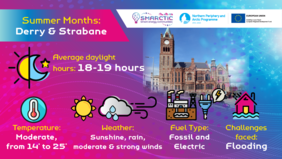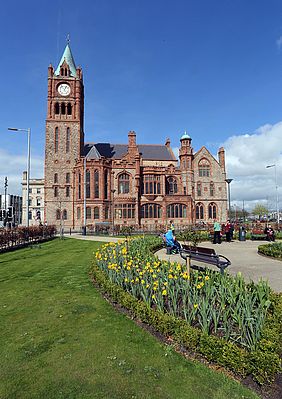SMARCTIC partner Derry City and Strabane District Council is the Local Authority for the City of Derry and Strabane District in Northern Ireland. This week we explore how the summer season affects the energy usage and indoor environment.
Derry & Strabane region is also located on the Northern Periphery of Europe and experiences moderate temperatures and high levels of rainfall for much of the year. The summer season lasts approximately 3 months, from June to middle September and the temperature averages at 18 degrees. In consequence, the summers are usually cool.
Even if it’s the drier season, the region also experiences a large amount of rainfall and can be prone to flooding during the summer months. In fact, the least month for rainfall is usually May. According to our SMARCTIC partner Leo Strawbridge, Energy Manager at Derry City and Strabane District Council, “typically, in August we normally see more thundery rainfall and as such there are more incidents of flooding. In August 2018 a particularly heavy period of rainfall over a short time period resulted in widespread flooding and damage to local infrastructure”. Typical Weather includes sunshine, rain, moderate and strong winds. Weather Spark website also mentions that, “in Derry, the average percentage of the sky covered by clouds experiences mild seasonal variation over the course of the year”.
Regarding daylight hours, the longest day is June 20, with 17 hours and 22 minutes of daylight. As it happens in the rest of the Northern Periphery of Europe, the length of the day varies extremely over the course of the year. However, both the length of days and the weather has a large bearing on the time spent indoors. Leo Strawbridge explains that the average time spent indoors may vary. “It depends on the weather. The more wind and rain, the more time you spend indoors. However, this trend has changed this year with the COVID-19, forcing more people to go out walking, running, enjoying the outdoors and having a staycation close to home”.
The summer months also impact in the energy consumption and indoor environment, although it doesn’t deviate greatly. Leo Strawbridge states that with longer warmer days, energy consumption will be lower than the winter months. “Air conditioning units are not used in domestic settings and they are limited to public buildings such as hospitals, etc. However, the region’s A/C load but is creeping up due to more humid days in July and August”, adds the Energy Manager.
SMARCTIC aims to encourage and facilitate SMART energy communities by using SMART technology and visualisation tools to educate and reduce energy use in the regions throughout the year; and to demonstrate effective implementation of intelligent solutions and renewable resources to reduce overall consumption.
Information obtained from Weather Spark.


